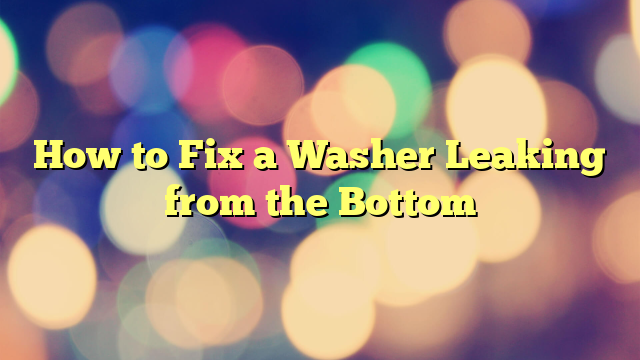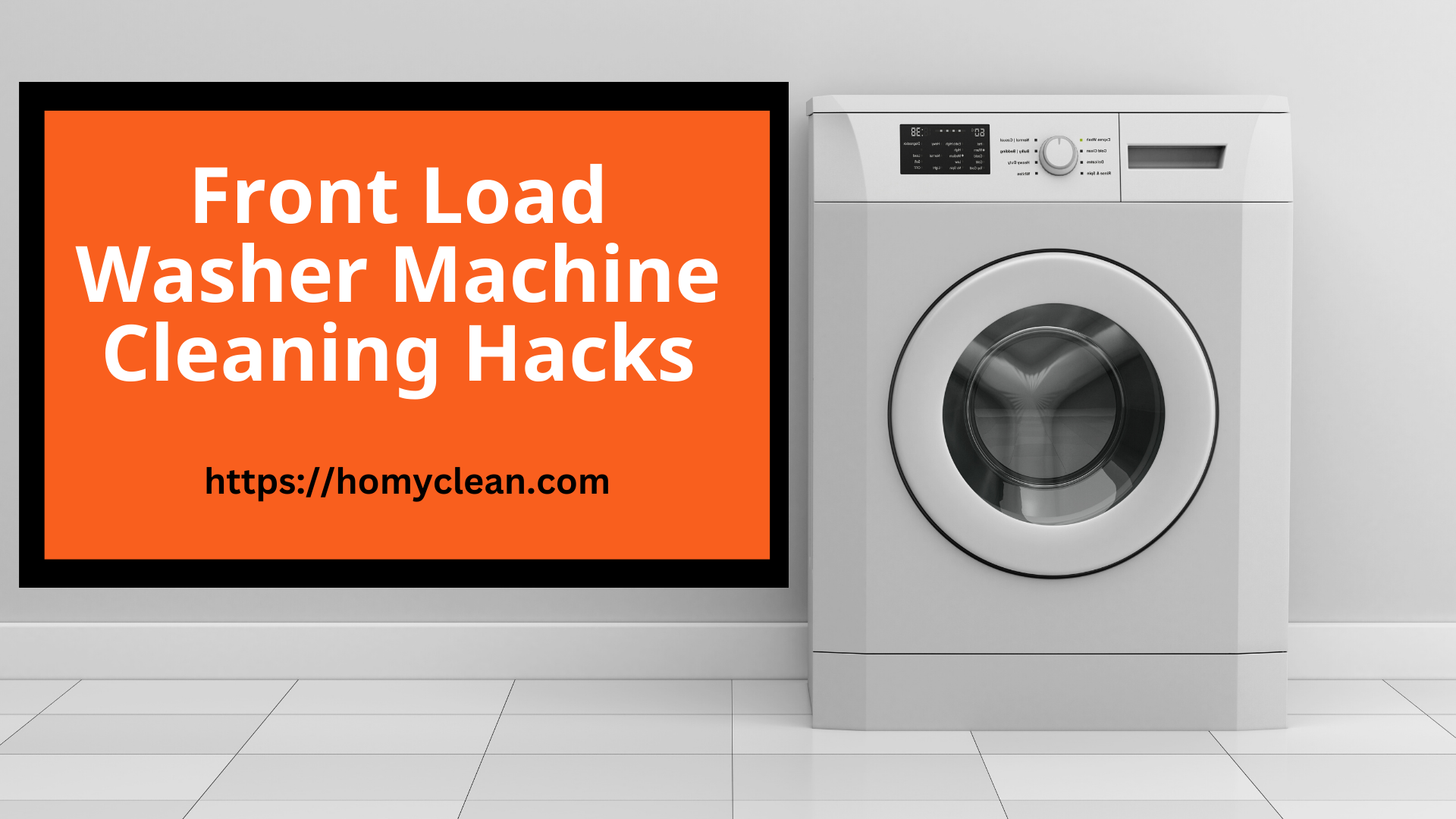You pile your dirtiest laundry into your trusty washing machine, dreaming of fresh, fluffy towels. But instead of the rhythmic hum of a cleaning champion, you hear a sinister “drip, drip, drip.” You peek behind the machine, and your heart sinks. Your once-gleaming laundry room floor is now a miniature ocean, courtesy of a leaky bottom washer.
Been there, soaked the floor? You’re not alone. Leaky washers are a common household woe, leaving us with soggy socks and a sinking feeling. But before you resign yourself to a lifetime of hand-washing delicates, take a deep breath. This guide is your weapon against the watery enemy, packed with troubleshooting tips and tricks to help you conquer that leaky bottom and reclaim your laundry room as a sudsy sanctuary.
The Easy Fixes
Before we dive into the mechanical underbelly of your washer, let’s tackle the low-hanging fruit. Sometimes, a leaky bottom can be solved with a little detective work and some basic tools.
1. The Hose Hunt
Start by following the trail of tears (water, that is). Check all the hoses connected to your washer for any visible cracks, punctures, or loose connections. Tighten any leaky clamps, and if a hose looks worse for wear, replace it with a spanking new one. Remember, a little preventative hose TLC can go a long way in keeping your laundry room dry.
2. The Level-Up Mission
Sometimes, a wonky washer can cause water to pool and escape in unexpected places. Grab a spirit level and check if your machine is standing tall and proud. If it’s leaning to one side like a tipsy sailor, adjust the leveling feet until it finds its equilibrium. A level washer is a happy washer, and a happy washer doesn’t weep all over your floor.
3. The Drain Dance
Your washing machine’s drain hose can get clogged with a surprising amount of laundry debris – lint, coins, rogue socks (they’re always up to something!). Disconnect the hose and give it a good cleaning. If something more sinister lurks inside, like a nasty clog, you might need a drain snake to clear the path.
4. The Gasket Gambit
The tub-to-pump hose and drain pump itself are sealed with gaskets, which can wear out over time. If you suspect a leaky gasket, you’ll need to access the internal workings of your washer. Grab your trusty repair manual, disconnect the power and water supply, and carefully remove the access panel. Locate the culprit gasket, assess its condition, and if it’s looking worse for wear, replace it with a fresh one. Remember, a good seal is a happy seal, and a happy seal keeps your laundry room dry.
5. The Clamp Crusade
Sometimes, loose or corroded hose clamps can be the sneaky culprits behind a leaky bottom. Inspect all the hose connections for rusty or damaged clamps. Replace any offenders with shiny new ones, and make sure they’re nice and snug but not overtightened (you don’t want to crush the poor hoses!).
3. The Pump Patrol
If your washer is leaking during the spin cycle, the culprit might be a faulty drain pump. Listen for unusual noises like grinding or gurgling, which can indicate a pump on its last legs. Consult your manual or call a professional to diagnose and potentially replace the pump. Remember, a healthy pump is a quiet pump, and a quiet pump means a peaceful laundry room.
Fix a Washer Leaking from the Bottom After Washing: Draining the Tears
Is your post-wash routine interrupted by a puddle at your feet? Don’t despair, that leaky bottom washer isn’t a permanent fixture. Let’s tackle this common woe and get your laundry room back in pristine, dry condition.
First Line of Defense:
- Hose Heroes: Inspect all connecting hoses for cracks, punctures, or loose connections. Tighten any leaky clamps, and if a hose looks worse for wear, replace it. A little preventative hose TLC can go a long way.
- Level Up: A wonky washer can cause water to pool and escape. Grab a spirit level and ensure your machine stands tall. Adjust the leveling feet until it finds its equilibrium. Remember, a happy, level washer is a dry laundry room.
- The Drain Dance: Clogged drain hoses are surprisingly common. Disconnect and clean it, or use a drain snake if there’s a deeper clog. A clear drain is a happy drain, and a happy drain means a happy you.
Deeper Dives:
- Gasket Gambit: The tub-to-pump hose and drain pump have seals (gaskets) that wear out. If you suspect a leaky gasket, consult your manual, disconnect the power and water, and access the internals. Assess the culprit gasket and replace it if needed. A good seal keeps the tears where they belong – in your sad movie marathons, not on your floor.
- Clamp Crusade: Loose or corroded hose clamps can be sneaky culprits. Inspect all connections and replace any rusty or damaged clamps with snug, new ones. Remember, happy clamps don’t leak!
- Pump Patrol: Leaky pumps often make unusual noises like grinding or gurgling during spin cycles. Consult your manual or call a pro to diagnose and potentially replace the pump. A quiet pump means a peaceful laundry room.
When in Doubt, Call in the Cavalry:
Don’t hesitate to call a qualified appliance repair technician if the issue seems complex, involves major component replacements, or you’re simply not comfortable tinkering. A pro can diagnose and fix the problem efficiently, saving you time, frustration, and potential water damage.
Remember: You’re not alone! Online forums and appliance repair communities offer support and advice. Share your woes and learn from others. You might just find the magic fix that saves your sanity and your floor.
Fix a Washer Leaking from the Bottom Clean: Spotless Solutions
A clean washer shouldn’t leak, but even the best machines can develop watery woes. Let’s get your sudsy sanctuary back in peak cleanliness and dryness.
Prevention is Key:
- Regular Checkups: Inspect hoses monthly for wear and tear. Replace them before they spring a leak.
- Level Habit: Check your washer’s level every few months and adjust the feet as needed. Imbalances can lead to leaks.
- The Quarterly Clean: Disconnect and clean your drain hose every quarter to remove potential clogs. A clear drain is a happy drain.
- Listen Up: Pay attention to unusual noises or changes in performance. Grinding, gurgling, or excessive vibration could be warning signs of trouble brewing. Address them promptly.
- Manual Magic: Your washer’s manual is your laundry bible. Consult it regularly for maintenance tips, troubleshooting advice, and specific instructions for your model. Knowledge is power, and laundry-wise knowledge keeps the suds flowing and the floors dry.
Cleaning Tactics:
- Wiping Wonders: Wipe down the exterior of your washer regularly to remove dust, debris, and potential mold growth. A clean exterior often means a cleaner internal environment.
- Vinegar Power: For stubborn grime, mix equal parts white vinegar and water in a spray bottle. Spray the solution on the affected areas, let it sit for 10 minutes, then scrub and rinse. Don’t forget to avoid spraying electrical components.
- Baking Soda Bonanza: For tough odors, sprinkle baking soda on the bottom of the washer tub and let it sit for an hour before running a hot water cycle with no clothes. Baking soda neutralizes odors, leaving your washer smelling fresh.
Fix a Washer Leaking from the Bottom Gasket: Sealing the Deal
Identify the Suspect: The tub-to-pump hose and drain pump both have gaskets prone to wear and tear, leading to leaks. Consult your washer’s manual to locate the specific gaskets you need to inspect.
Tool Time: Gather your tools! You’ll likely need a screwdriver, pliers, a bucket, rags, and possibly a flashlight. Safety first, so disconnect the power and water supply before starting.
Access Granted: Remove the access panel according to your manual’s instructions. This might involve unscrewing panels or popping off clips. Be careful not to damage any wires or components.
Gasket Gauntlet: Inspect the suspected gaskets for cracks, tears, or deformation. If they look worn or damaged, it’s time for replacements. Consult your manual or the internet for the correct replacement part numbers.
Gasket Genius: Carefully remove the old gasket, making note of its position and orientation. Install the new gasket in its place, ensuring it’s snug and properly seated. Consult your manual for specific installation instructions.
Testing Time: Reconnect the access panel, power, and water supply. Run a test cycle on an empty setting to check for leaks. If all is well, you’re a leak-slaying hero!
Pro Tip: Consider replacing both gaskets (tub-to-pump and drain pump) simultaneously, even if only one appears worn. This can save you time and trouble in the long run.
Remember: Replacing gaskets requires some technical know-how and comfort working with tools. If you’re unsure about any step, don’t hesitate to call a qualified appliance repair technician. They can handle the tricky bits and ensure your washer is back in leak-free operation.
Fix a Washer Leaking from the Bottom Kenmore: Banishing the Blue Swoosh Woes
Is your trusty Kenmore weeping at your feet? Don’t fret, leaky woes can befall even the best washing machines. Let’s diagnose and conquer the puddle problem for your specific Kenmore model.
Model Matters:
The first step is identifying your Kenmore model number. It’s usually located on a sticker on the back or side panel of your washer. Knowing the model helps access specific troubleshooting guides and repair instructions.
Common Culprits:
Once you have your model number, consult online resources or the Kenmore website for common leak points specific to your model. You might find helpful troubleshooting guides, diagnostic tips, and even video tutorials tailored to your Kenmore’s intricacies.
Hose Heroes:
Don’t underestimate the power of a leaky hose! Inspect all connecting hoses for cracks, punctures, or loose connections. Tighten any leaky clamps, and if a hose looks worse for wear, replace it with a Kenmore-compatible one.
Gasket Gambit: As mentioned earlier, worn-out gaskets can be behind bottom leaks. Consult your Kenmore manual or online resources to identify the relevant gaskets for your model and follow the gasket replacement steps outlined in the previous section.
Pro Tip: Kenmore offers genuine replacement parts specifically designed for their washers. Opting for these can ensure proper fit and performance, potentially saving you headaches and repeat repairs.
Call in the Cavalry:
If your DIY attempts prove unsuccessful, or the issue seems complex, don’t hesitate to contact a qualified appliance repair technician. They’ll have the expertise and tools to diagnose and fix your Kenmore washer efficiently, restoring your laundry room to its dry and sudsy glory.
Remember: Armed with your Kenmore model number and some troubleshooting spirit, you can tackle most leaky woes. But don’t be afraid to call in the pros if needed. A happy, dry Kenmore is a testament to your laundry warrior skills!
Fix a Washer Leaking from the Bottom Kenmore Elite
Advanced Diagnostics: Elite models might have built-in diagnostic features that can pinpoint the source of the leak. Familiarize yourself with these features and how to interpret any error codes displayed. This can save you time and effort in troubleshooting.
Hose Heroes: As with any washer, inspect all connecting hoses for cracks, punctures, or loose connections. Tighten any leaky clamps, and if a hose looks worse for wear, replace it with a Kenmore Elite-compatible one. Remember, premium hoses can offer enhanced durability and leak resistance.
Gasket Gambit: Worn-out gaskets can be culprits in Elite models as well. Consult your manual or online resources to identify the specific gaskets for your model and follow the gasket replacement steps outlined in the previous sections. Opting for genuine Kenmore Elite replacement gaskets can ensure optimal fit and performance.
Sensor Savvy: Elite models often have advanced sensors that monitor water levels and flow. If a sensor malfunctions, it could lead to inaccurate readings and potential leaks. Consult your manual or contact Kenmore customer service for guidance on diagnosing and potentially replacing faulty sensors.
Pro Tip: Consider investing in a professional preventative maintenance service for your Kenmore Elite washer. This can help identify potential issues early on and prevent costly repairs down the line.
Remember: While Kenmore Elite washers are built for superior performance, they’re not immune to leaks. By combining your troubleshooting skills with your manual’s guidance and potentially seeking professional help, you can conquer those watery woes and keep your laundry room a luxurious, sudsy haven.
Fix a Washer Leaking from the Bottom Maytag
Even the dependable Maytag can succumb to the occasional leak. But fear not, laundry warriors! Let’s tackle the issue and restore your Maytag to its leak-free, suds-slinging glory.
Maytag Magic:
The first step is identifying your Maytag model number. You’ll find it on a sticker on the back or side panel. Knowing your model helps access specific troubleshooting guides and repair instructions tailored to your Maytag’s unique features.
Hose Heroes: Don’t underestimate the power of a leaky hose! Inspect all connecting hoses for cracks, punctures, or loose connections. Tighten any leaky clamps, and if a hose looks worse for wear, replace it with a Maytag-compatible one. Remember, genuine Maytag hoses offer guaranteed quality and fit.
Gasket Gambit: As mentioned earlier, worn-out gaskets can be behind bottom leaks. Consult your Maytag manual or online resources to identify the relevant gaskets for your model and follow the gasket replacement steps outlined in the previous sections. Opting for Maytag-approved replacement gaskets ensures optimal performance and longevity.
Overflow Alert: Some Maytag models have built-in overflow sensors that can trigger a leak if the water level rises too high. Check your manual or contact Maytag customer service for guidance on diagnosing and potentially resetting the overflow sensor.
Pro Tip: Maytag offers a comprehensive online troubleshooting tool. Simply enter your model number and the issue you’re facing, and the tool will provide step-by-step instructions and helpful videos tailored to your specific Maytag machine.
Remember: With a little detective work and the help of Maytag’s resources, you can conquer most leaky woes. But don’t hesitate to contact a qualified appliance repair technician if the issue seems complex or requires advanced expertise. A happy, dry Maytag is a testament to your laundry warrior skills!
Fix a Washer Leaking from the Bottom of the Dishwasher
Your dishwasher’s job is to clean, not create watery messes. If your dishwasher is leaking from the bottom, let’s diagnose the issue and restore your kitchen to a leak-free, gleaming haven.
Hose Heroes: First things first, inspect all connecting hoses for cracks, punctures, or loose connections. Tighten any leaky clamps, and if a hose looks worse for wear, replace it with a dishwasher-compatible one. Remember, quality hoses can prevent future leaks and headaches.
Seal the Deal: Leaky seals around the door or pump can also be culprits. Consult your dishwasher’s manual to identify the specific seals and follow the replacement instructions outlined in the previous sections. Opting for genuine dishwasher replacement seals ensures optimal fit and performance.
Filter Frenzy: A clogged drain filter can cause water to back up and leak from the bottom. Locate your dishwasher’s drain filter, clean it thoroughly, and ensure it’s properly seated. A clean filter keeps the water flowing smoothly and prevents leaks.
Level Up: An uneven dishwasher can also lead to leaks. Grab a spirit level and check if your machine stands tall and proud. Adjust the leveling feet until it finds its equilibrium.
Related Topics:
10 FAQs about Fixing a Leaky Washer from the Bottom
My washer is leaking from the bottom after washing. What could be the problem?
Several things could be causing the leak, including loose hose connections, worn-out gaskets, a clogged drain hose, or even a faulty pump. Start by visually inspecting the hoses and the bottom of the washer for any obvious leaks.
How can I fix a leaky hose on my washer?
Check for loose clamps and tighten them if necessary. If a hose is cracked or damaged, you’ll need to replace it with a new one. Make sure to get the right size and type of hose for your washer model.
What are gaskets, and how can they cause a leak?
Gaskets are seals that prevent water from leaking between different parts of the washer. Over time, gaskets can wear out or crack, allowing water to escape. If you suspect a leaky gasket, you’ll need to identify and replace it with a new one.
How can I clean the drain hose on my washer to prevent leaks?
Disconnect the hose from the back of the washer and drain any remaining water. Then, use a long snake or a wet rag to remove any clogs or debris. Finally, reconnect the hose securely.
My washer is making gurgling noises during the spin cycle. Is that related to the leak?
Gurgling noises could indicate a clogged drain pump, which can cause water to back up and leak from the bottom. You might need to clean or replace the drain pump to fix the problem.
Is it okay to try fixing a leaky washer myself, or should I call a professional?
If the leak is simple and you’re comfortable working with tools, you may be able to fix it yourself. However, if the leak is complex or involves replacing major components, it’s best to call a qualified appliance repair technician to avoid causing further damage.
What can I do to prevent my washer from leaking in the future?
Regularly check your hoses and gaskets for signs of wear. Clean the drain hose every few months. Level your washer properly using a spirit level. Pay attention to any unusual noises or changes in performance, as these could be early warning signs of a problem.
Is it covered by my warranty if my washer starts leaking?
This depends on your specific warranty and the age of your washer. Check your warranty booklet or contact the manufacturer for more information.
Where can I find more information and troubleshooting tips for fixing a leaky washer?
You can find helpful information in your washer’s owner’s manual. Also, many appliance manufacturers have online troubleshooting guides and resources. Additionally, online forums and communities can offer helpful advice and support from other appliance owners.
Is there anything else I can do to protect my laundry room from potential leaks?
Consider investing in a water leak detector and alarm system. This can alert you to a leak early on, before it causes major damage. You can also install a floor drain in your laundry room to help prevent water damage in case of a leak.





